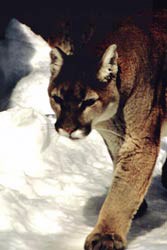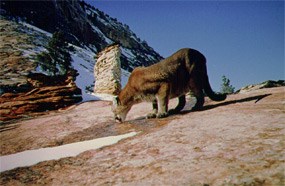|
Common Name: Mountain Lion Scientific Name: Felis concolor Size (length) English & Metric: 6'-9' (1.5-2.75 m) Habitat: all mountainous regions and swamps Diet: commonly deer but also anything from elk to mice Predators: wolves, other Mountain Lions 
NPS Also known as cougar, puma, panther, yellow cat, catamount, etc., the Mountain Lion is North America's second largest member of the cat family, after the Jaguar. These majestic creatures once roamed throughout North America, but today, their range is limited to British Columbia and Alberta, Canada, the twelve westernmost states in the US, and Florida. Sighting a wild Mountain Lion is a rare and unexpected event. So unexpected that it's common for people to initially mistake them for deer even though the only things deer and Mountain Lions have in common are four legs and similar colored fur. These large cats, as adults, can be 30 inches in height at the shoulder, and approximately 8 feet long from nose to tail. The tail of the Mountain Lion is about one-third the entire length of the body. Mountain Lions usually weigh between 75-175 pounds. The largest Mountain Lion ever to be documented weighed 276 pounds, but a Lion of this size is extremely rare. The coat of the Mountain Lion is light brown in color, and the fur is short and coarse. The underside of the cat is white, and the tail is tipped in black. Variations in the color of the lion's coat have been listed as rust, apricot, lemon, smoke, and even black. Biology & Behavior: The vision of the Mountain Lion is one of the animal's most important adaptations for hunting. The animal's eyes are quite large, and the retina contains more rods than cones, lending to the cat's excellent night vision. Although Mountain Lions cannot see in complete darkness, they can discern details in much lower light than humans. In addition to its' excellent vision, the Mountain Lion has extremely sensitive hearing. This is also an important tool for hunting in low light. Lions can detect high frequency sounds that allow them to detect hidden prey. By comparison, Mountain Lions have a weak sense of smell. This is the trade-off cats made millions of years ago. Evolving short muzzles increased biting power, but decreased the sense of smell. Mountain Lions are known as ambush hunters. The lion waits patiently in dense vegetation or rock crevices for prey to wander by. Then, silent stalking of the prey is followed by a quick surprise attack by the powerful cat. A popular myth is that Mountain Lions jump out of trees or off of cliffs to attack their prey. In actuality they may leap from a high hiding place to build up speed for the attack, but at the point of impact, they keep their hind legs on the ground for balance and, if necessary, a quick escape. When attacking large animals, Mountain Lions go for the neck. Their jaws are powerful enough to break the neck of a deer or smaller animal. Alternatively when attacking larger animals such as elk or even horses, Mountain Lions choose to clamp down on the windpipe, strangling the victim. While deer is their preferred food throughout their range, Mountain Lions also feed on mice, ground squirrels, rabbits, skunks, porcupines, and birds. One lion can consume up to 20 or 30 pounds of meat in a single meal. After feeding on its kill, the lion will cache the prey, or bury it in a secluded spot. The Mountain Lion will return to feed on the prey for up to 10 days. The range of a Mountain Lion may cover 25 to 785 square miles. Here in southern Utah, lions have been known to occupy home ranges as large as 513 square miles. The size of a lion's territory depends on the availability of food and habitat quality. Mountain Lions are solitary animals, only seeking company during the breeding season. Mountain Lions are capable of breeding at any time during the year. In the west, it has been discovered that the kittens are usually born during June or July. During the breeding season, the famous scream of the female lion may be heard. This scream is used to attract the male lion. After the female chooses her mate, the two lions will remain together for several days, hunting and playing until the female is ready to mate. After approximately three months, the kittens will be born. The female will choose a den, which could be a rock overhang, shallow cave or area of dense vegetation, as a secure place to give birth. Mountain Lion kittens are born with a spotted coat and bright blue eyes. The spots disappear after 6-9 months, and the eyes turn yellow within 16 months. Weighing in at about one pound at birth, the kittens grow rapidly. After eight weeks of nursing, the kittens will weigh about 30 pounds. Lion kittens begin to eat meat at the age of six weeks. After 18 months, the immature lions usually leave their mother to begin life on their own. Life is tough for juvenile lions. Dominant males may kill juveniles within their territories, so often juveniles must eke out a living in marginal habitat. This can ultimately lead to starvation or encounters with humans. Even in California where Mountain Lions are protected from hunting, 75% of the kittens do not live to be two years old. Conservation Issues: Bounty hunting of Mountain Lions began as early as the 1600s in North America. Early settlers feared the Mountain Lions, and believed that the lions, as well as wolves and bears, had a negative effect on game populations. By the 1900s these predators had been killed in astonishing numbers, with a disastrous effect on the ecosystem in some areas. Loss of predators led to overpopulation of deer and other herbivores, resulting in overgrazing, increased erosion and decline in the long-term health of whole ecosystems. Bounty hunting continued across the nation until the 1960s, when efforts began to preserve environmental health. Mountain Lions survived the persecution better than other predators, yet Mountain Lion populations have not been restored in many areas. People are not always eager to help predator populations recover. Livestock losses are a source of concern because individual Mountain Lions have been documented wantonly killing dozens of sheep in a single night. As widely publicized as these accounts are, they do not occur regularly. However, because Mountain Lions are such successful predators (they can just as easily kill a bull elk as a domestic sheep), as long as there are plenty of deer for them to hunt they tend to leave livestock alone. As a rule, Mountain Lions avoid people and signs of people, but in recent years, Mountain Lion attacks on humans have become a serious source of controversy. Although attacks on humans are extremely rare, the attacks have increased over the past few decades. As in most livestock depredations, the Mountain Lion that attacks a person is usually a hunger-crazed juvenile that has been pushed into marginal habitat by more dominant males. But it is human encroachment into Mountain Lion territory that creates marginal Mountain Lion habitat. As more people are recreating and living in rural areas, the chance of an encounter with these secretive animals is more likely. Nevertheless, by taking some precautions humans and Mountain Lions can coexist. In the event that you encounter an aggressive Mountain Lion:

NPS When and Where to See Mountain Lions at Bryce Canyon: Mountain Lions are most active in the winter because snow offers them several advantages over their prey. Large paws help Mountain Lions sprint over deep snow that deer or elk flounder in. Lacking a strong sense of smell, Mountain Lions have difficulty tracking prey in the summertime, so instead they wait in ambush for prey to come to them. However, in the winter, Mountain Lions will visually track deer by following their hoof-prints in the snow. But before you plan a winter backpack trip in an attempt to see a Mountain Lion, keep in mind that backpacking in winter at Bryce poses far more dangerous risks than Mountain Lions. Don't be discouraged. While actual sightings are rare, encountering evidence of Mountain Lion passing is fairly common if you know what to look for. Tracks are readily identifiable in that they are similar to those of a Great Dane or other very large dog, but with one obvious difference: Mountain Lions walk with their claws retracted so you will see only the round toe prints without the triangular claw marks. Sometimes it's your nose that alerts you to presence of a Mountain Lion. If you find a small pile of dirt that smells strongly of cat urine you have found a scent mound used for marking territory.At other times, circling vultures or ravens might indicate the location of a Mountain Lion food cache. NOTE: A Mountain Lion periodically returns to its food cache or may just rest between meals hidden nearby. Therefore, investigating a Mountain Lion food cache is fine if you can fly like a raven, but otherwise it is a very dangerous idea. Perhaps it is a good thing that Mountain Lions are exceedingly difficult to see. Ultimately this keeps people from running into trouble with Mountain Lions and vice versa. Sources: Whitaker, John O. 1996. National Audubon Society Field Guide to North American Mammals. Alfred A Knopf, Inc. p937. |
Last updated: February 14, 2023
